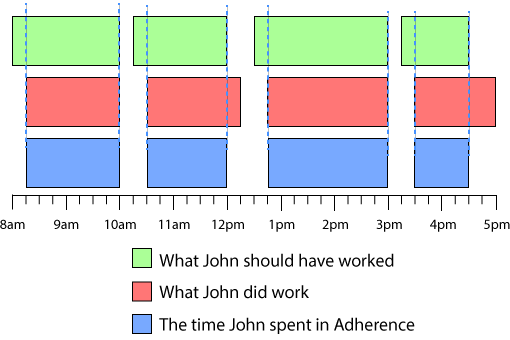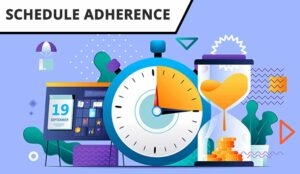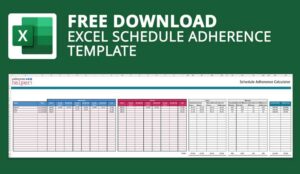Managing schedule adherence can be tricky, but the process below may be helpful in providing some great ideas for improving the contact centre metric.
Start by Defining the Schedule Adherence Problem
A common problem in contact centres is that staff are unaware of just how big a problem low schedule adherence is.
Being five or ten minutes late in a contact centre is a much bigger deal than in other industries.
Many contact centre team members often don’t understand that being five or ten minutes late in a contact centre is a much bigger deal than in other industries.
So one of the very first things that you should be doing is defining and “justifying” the problem, by putting some numbers next to it.
To do this, you want to examine schedule adherence from the perspective of your three main stakeholder groups:
- Your Customers – Adherence impacts customer wait times and speed of answer
- Your Contact Centre Team – Adherence impacts staff workload and occupancy rates
- Your Senior Management and the Wider Business – Adherence impacts cost of the operation (i.e. “lost time” and cover workers)
To show what an impact adherence has on the first two of these areas, let’s take a look at the following table and consider: what if 5% of our advisors aren’t where they are supposed to be?
| Time of Day | Forecast Calls | Forecast AHT | Forecast Staff | Actual Staff | Net Staff | SLA Target = 80% in 20 secs |
|---|---|---|---|---|---|---|
| 6:00 | 280 | 215 | 40 | 38 | -2 | 77.5% |
| 6:30 | 310 | 215 | 44 | 41 | -2 | 79.4% |
| 7:00 | 350 | 215 | 50 | 47 | -3 | 79.4% |
| 7:30 | 380 | 215 | 54 | 50 | -3 | 81.1% |
| 8:00 | 420 | 215 | 60 | 57 | -3 | 86.0% |
| 8:30 | 450 | 215 | 64 | 61 | -3 | 87.5% |
From the table we can see that, with just 5% of staff missing, we are failing to hit our service level targets during certain periods, causing answer times to spike. This negatively impacts customer experience.
But we may also say that we are hitting our target service level at certain times too. This is true, but we haven’t considered the impact of low schedule adherence on our advisors yet.
So, let’s take a closer look at that. Here is more data that shows how missing a certain number of advisors has other consequences too – using the time of 7am from the example above.
| Time of Day | Forecast Staff | If This Many Staff Showed Up | SLA Target = 80% in 20 secs | Average Speed of Answer (ASA) | Occupan-cy Rate (target 85%) |
|---|---|---|---|---|---|
| 7:00 | 50 | 50 (scheduled) | 92.8% | 4.1 secs | 83.6% |
| 7:00 | 50 | 49 | 89.6% | 6 secs | 85.3% |
| 7:00 | 50 | 48 | 85.3% | 9.1 secs | 87.1% |
| 7:00 | 50 | 47 (turned-up) | 79.4% | 13.8 secs | 88.9% |
| 7:00 | 50 | 46 | 71.5% | 21.6 secs | 90.9% |
| 7:00 | 50 | 45 | 60.9% | 35.4 secs | 92.9% |
From this table, we can see that just from having three people missing, service level drops by 13.6% and Average Speed of Answer plummets (and then some!).
But we can also see that our occupancy rate has moved from 83.6% to 88.9%. This gives advisors little more than 11% idle time between calls, which is a surefire way to achieve advisor burnout.
Just missing three people has caused everyone’s idle time to drop by a third. So we really need to understand the relationship between adherence and occupancy and teach advisors about the power of one rule and how adherence impacts them.
So don’t just think of the impact schedule adherence has on the customers, acknowledge that low adherence can have a very real negative impact on the advisors who showed up too.
A Game for Teaching Advisors About “The Power of One” Rule
Schedule adherence can be much easier to manage if advisors understand the power of one rule, as mentioned above.
This game will help you to help your team understand this. It was shared with us by Doug Casterton, a Senior Workforce Management (WFM) Manager, in a recent episode of The Contact Centre Podcast.
The game begins by forming a group of advisors and giving them each a balloon. For this example let’s say there are ten balloons and ten advisors.
The advisors have to juggle the balloons, one at a time, and stop the balloons from hitting the ground. Then you take one advisor away.
Between the group of ten people, the advisors have to juggle the balloons, one at a time, and stop the balloons from hitting the ground. Then you take one advisor away.
You can immediately see the impact of how difficult it is to keep those balloons up with just one advisor coming out.

Doug Casterton
Every dropped balloon represents a dropped contact, and make sure you point out to your team how much harder they all had to work with just one person missing.
Doug does have a key message that comes with this game: “Make sure you clear it with health and safety first!”
To hear more valuable insights from Doug on the link between WFM and employee engagement, listen to the following episode of The Contact Centre Podcast.
The Contact Centre Podcast – Episode 22:
Resource Planning Advice To Boost Efficiency And Engagement
For more information on this podcast visit Podcast – Resource Planning Advice to Boost Efficiency and Engagement
Take a Look at the True Costs of Poor Schedule Adherence
We have highlighted that poor schedule adherence costs us in terms of poor customer service, but it also costs us in other ways.
For example, if we are factoring low schedule adherence into our staffing calculations through shrinkage, there is a replacement cost there for non-adherence.
We also have another cost in “lost time”. This means that we are paying someone to do the work, but they are not there or are unavailable.
An Example of the Cost of “Lost Time”
Let’s take a quick look at a simple example where we look at how much money we lose from “lost time” every year.
Let’s say that we have a contact centre of 100 advisors, all working five days a week, 47 weeks a year. On average, we lose 10 minutes from them every day due to low schedule adherence. We pay each advisor £9.50 an hour.
10 minutes x 5 days x 47 weeks = 2,350 minutes a year= 39.2 hours per year
39.2 hours x £9.50/hr x 100 advisors = £37,240 per year
From these calculations, we can see that just 10 minutes per advisor of lost time is costing us £37,240 a year. That is before we look at the other costing impacts of low adherence, like telephone costs and increased shrinkage.
So, if we manage adherence better and think about how we can gain a little bit of that ten minutes back, we can make some significant cost savings.
Determine How You Will Measure Adherence
As the old saying goes: if you can’t track it, you can’t manage it. So how do you measure schedule adherence?
To explore how to track adherence, let’s take a look at the following example from a person we will call John.

For John to achieve 100% schedule adherence, those green and red blocks need to match up, but they don’t – as highlighted in the bullet points below:
- John’s total scheduled minutes = 450
- John’s total sign-on minutes = 435
- John’s total time in adherence = 390 (i.e. where the green and red overlap)
So while we do have 435 minutes’ work compared to the 450 minutes scheduled, only 390 minutes of that was at the right time.
John’s schedule adherence would therefore only be 86.7%, as calculated through the schedule adherence formula below:

John’s Schedule Adherence = (390/450) x 100 = 86.7%
If everyone follows John’s pattern, that’s going to completely throw us off and we are not going to have the workforce in place when the workload arrives.
So we really need to define this clearly to advisors when teaching them about the power of one that it is not about the number of minutes, but the right minutes.
As Alexander, one of our readers, says: “I find the best way to encourage schedule adherence is to fully explain the effect and reasoning behind any constraints placed on the advisors. This helps them to be invested in and feel responsible for their schedule adherence.”
We can measure and track our progress in improving schedule adherence by using the formula above.
To find out how to measure schedule adherence in the contact centre, read our article: How Do I Calculate… Schedule Adherence?
Set Reasonable Schedule Adherence Goals
It’s very important that advisors understand schedule adherence and how it is in their control – so it is good to set them an achievable percentage adherence goal.
If we allow advisors five minutes around break times, ten minutes around lunch, that will quickly add up. We need to find a goal that is reasonable for both advisors and us, with the reasoning clearly communicated to the team.

Penny Reynolds
This communication is important, as Penny Reynolds, Founding Partner at The Call Center School, told us a few years ago: “We were working with a contact centre that had a goal of 92% adherence. So, for advisors working an eight-hour day, they were getting a safety net of a little more than 30 minutes a day.”
“Well, guess what? Every single person in the centre felt obliged and entitled to take all 33 minutes of that. Many were even taking an extra 30 minutes for lunch, all at one time, but still hitting their target.”
That’s crazy, but if the contact centre changed their target to 96%, for example – adding that to advisor scorecards and supervisor performance reviews – team morale will be hit and you will likely get some manipulation of adherence figures.
So, the key with setting schedule adherence goals is to ensure that they are achievable, manageable and practical upfront. But we also must stick to them.
To set a schedule adherence goal like this, Penny also recommends that we:
- Consider the average handle time (AHT) of calls
- Analyse the likelihood of a very long call
- Identify all of the barriers that may prevent adherence
- Involve frontline staff in defining what’s reasonable
- Define minimum expectation (pass/fail)
- Define “grades” of schedule adherence
The first bullet point here is particularly interesting. If one contact centre has an AHT of 3 minutes and another 15 minutes, there is no way that they should have the same schedule adherence goal. This is because advisors in the latter contact centre will have to take calls that run longer into their break-time.
Also, the final point of setting grades is also key, as that will prevent advisors from treating the schedule adherence “safety net” as if it’s an allowance of more break-time.
Diagnose and Address Adherence Problems
Let’s move away from all of the maths for a moment and consider the psychology behind schedule adherence.
While there will be advisors who are constantly in the right place at the right time, there will also be those that are consistently failing to hit their targets. So let’s consider: why? Diagnosing this is important in order to address root cause.
With this in mind, here are three of the most common reasons for schedule adherence problems in the workplace. These are:
1. Don’t Know – This means that advisors are unaware of our schedule adherence expectations of them or, more commonly, they are aware but aren’t getting enough feedback as to how well they are doing.
You can address these problems by:
- Power of one training
- Publishing individual and team adherence reports
- Implementing real-time notifications of schedule adherence
2. Can’t – By this we mean that there is an obstacle to achieving schedule adherence, which could be long calls running into break-times or health needs, for example.
You can address these problems by:
- Uncovering “can’t reasons” through employee feedback
- Addressing “can’t reasons” in coaching
- Adapting processes to remove the “can’t reason”.
3. Won’t – This is exactly what it sounds like. Advisors could do it if they wanted to, but they decide not to do it. This could be due to a lack of motivation or improper consequences, which may be either:
- They are experiencing a negative consequence for a positive behaviour
- (OR!) They are experiencing a positive consequence for a negative behaviour
You can address these problems by reconsidering your consequences, remembering that the most effective consequences are positive, immediate and certain.
For more on ensuring that you have the right consequences in place to go alongside your schedule adherence strategy, watch the video below where Penny discusses this further.
Finally, in terms of addressing adherence, it can work well to reward advisors for good adherence grades. It doesn’t have to be a monetary reward. Be creative with the different rewards you can use.
For example, allowing advisors with good schedule adherence to pick their holiday weeks first can work well.
For more ideas on how to reward advisors, read our article: How to Make the Most of Your Staff Incentives – With Examples
Increase Advisor Engagement
In the last point we recognized that poor schedule adherence may be down to there being a lack of consequence for advisors not sticking rigidly to schedule. This ties in with another key reason: lack of motivation.
To overcome this barrier to good schedule adherence, there are many employee engagement initiatives to try – like the following three examples sent in by our readers:
- Examine your shift patterns and consider moving to annualized hours. This can help with lateness and breaks – Thanks to Jamie
- Consider the impact of leadership. I did a research project on engaging managers and carried out focus group sessions. The strongest response was: “a manager who knows me as a person, who knows what matters to me most” – Thanks to Shona
- Focus on employee well-being. If an employee is always late, that may be a sign that you need to pay more attention to their well-being. So put things in place that can help, clearly signposting what they are and where they can be found. – Thanks to Claire
Chris Dealy, a Customer Experience Leader at injixo, also recommends implementing WFM systems that include personal advisor portals to better manage adherence.
The intended outcome of implementing such a portal is that we increase advisor engagement while also addressing our three key adherence problems: don’t know, can’t and won’t.
Chris outlines how having personal portals within the WFM system can do so below:
Increases Advisor Engagement:
- Schedule adherence stats easily located on desktop
- Schedule information can also be accessed via smartphone/tablet
Reduce “Don’t Know”:
- Visibility of shifts
Reduce “Can’t”:
- Pop-up notifications
Reduce “Won’t”:
- Self-service shift-swapping
- Self-service holiday requests
- Shift bidding
For more on how you can drive employee engagement in the contact centre, read our article: How to Improve Agent Engagement
Strategize Your Adherence Reporting and Monitoring
The ability to get accurate reports on schedule adherence is key, as if you can’t measure schedule adherence, you cannot measure it, while we also want to be sure that adherence statistics cannot be manipulated in any way.
Historical adherence and conformance reports from inside your WFM system will be very helpful here and can really fit the bill when it comes to one-to-ones and appraisals.
Why? Because when advisors are aware that you have the facts and figures right in front of you, it makes the consequences much more certain.
However, a potentially even better strategy to reporting and monitoring adherence can be formulated if you have the capability to monitor schedule adherence in real time.
As Chris says: “Using the necessary supporting tools, you can perform timely corrective action, which makes the consequences of schedule adherence more immediate.”
When you can report on schedule adherence in such a way, you help prevent adherence and scheduling from becoming an isolated area of performance management. Instead it starts to become part of the business ethos.
Final Thoughts
If you can string each of these seven key parts of managing schedule adherence in the contact centre together, you will likely be able to better control and improve this key metric.
On that note, we would just like to leave you with three final tips from our readers for how they successfully manage schedule adherence in their contact centre.
- We aim to achieve the same schedule adherence target that we have met previously, so as to not be unrealistic, and then increase accordingly as performance improves. – Thanks to Jamie
- You definitely need buy-in from management. To help do this, our resource team put together a “financial cost of non-adherence” presentation for the management team. – Thanks to Donna
- Use a tagging system so that the advisors can only go when their buddy comes back, ensuring that too many people aren’t off the floor and people keep to times. – Thanks to Heather
Good luck!
These final tips were included as part of our article: Top Tips for Improving Attendance and Adherence
For more on the topic of managing and improving schedule adherence:
- Download Our Free Schedule Adherence Tool
- A Beginner’s Guide to Adherence Management
- 17 New Ways to Improve Schedule Adherence in the Contact Centre
Author: Robyn Coppell
Published On: 12th Aug 2020 - Last modified: 13th Aug 2025
Read more about - Workforce Planning, Absenteeism, Adherence, Chris Dealy, Penny Reynolds, Scheduling, Workforce Planning





































